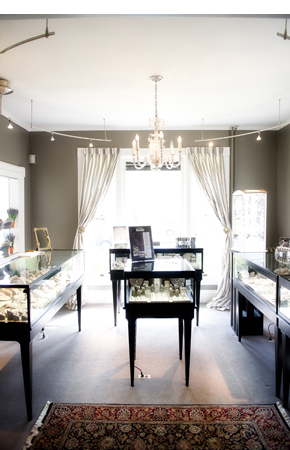 Lucky are those born in the fourth month for their birthstone is the incomparable diamond. From atop its perch on the MOHs scale of mineral hardness, diamonds rank as the toughest mineral on earth.
Lucky are those born in the fourth month for their birthstone is the incomparable diamond. From atop its perch on the MOHs scale of mineral hardness, diamonds rank as the toughest mineral on earth.
A sparkling white diamond is not the only choice. How about a colored stone for a new twist on tradition? In lovely shades of blue, champagne, pink and chocolate, colored diamonds offer April birthdays new style to celebrate.
So what is the story with fancy-colored diamonds?
Customers frequently ask us if these gems are less valuable than their colorless and near-colorless counterparts. The answer is “yes” and “no.” Fancy-colored diamonds are rarer and can command a higher price-per-carat; however, there is typically a greater demand for the traditional whites, which impacts their price.
Fancy-colored diamonds, such as the deep blue Hope Diamond, are among the most valuable and sought-after gemstones in the world. In 2009, a 7-carat blue diamond sold at auction for $9.5 million, or $1.3 million per carat. This record was broken in 2013 when an orange diamond sold for $35 million or $2.4 million per carat. A pink diamond challenged this in October 2014 at a Sotheby’s sale in Hong Kong when an 8.41-carat pink diamond sold for $17,768,041 – more than $2.1m a carat.
Are they graded like white diamonds?
Gemologists evaluate all colored diamonds less for brilliance or fire and more for color intensity. Shades that are deep and distinct are rated higher than weak or pale shades.
Diamonds typically range from colorless through light yellow and are described using the Gemological Institute of America’s (GIA) D-to-Z color-grading scale (D being colorless). Fancy color diamonds, on the other hand, are yellow and brown diamonds that exhibit color beyond the Z range, and also include diamonds that exhibit any other color face-up. These rare specimens have many shades, including blue, green, pink and red.
GIA debuted an expanded and enhanced Colored Diamond Color Grading System in 1994. The 20-year-old system has been trusted with grading virtually every important colored diamond that has gone to auction, as well as many of the colored diamonds sold around the world.
What causes these stones to have color?
While fancy-color diamonds are created under the same intense pressure and temperature as regular diamonds, they have a unique difference. When the stone traps foreign particulates during the crystallization process, it changes the chemical process and final color of the gemstone. Yellow diamonds contain traces of nitrogen, and blue diamonds contain boron.
Interestingly, no similar impurities have been found in pink diamonds, leading scientists to speculate that the color may be the result of some kind of seismic shock that altered the stone’s molecular structure, creating pink zones (called twin planes) that alternate with clear areas.







No comments yet.